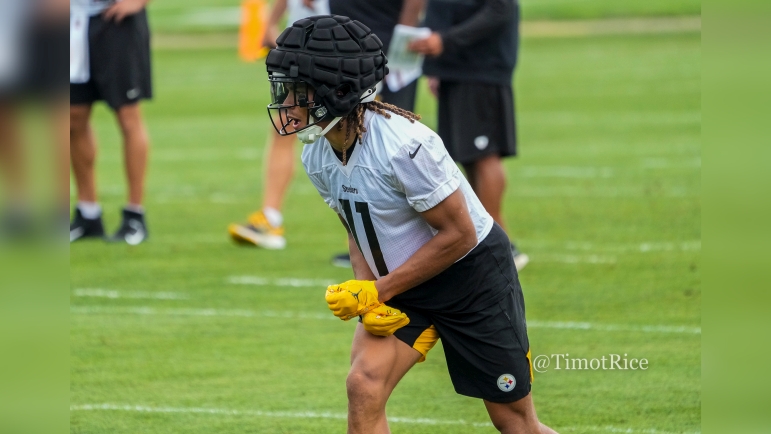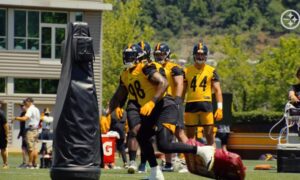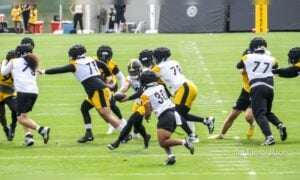After playing primarily as a Z-receiver for the Pittsburgh Steelers in his first two seasons in the NFL, Chase Claypool has found himself as the team’s starting slot wide receiver. Often times when you hear “slot receiver” you normally think of the short, quick guys that are wicked route runners. Names like Julian Edelman, Wes Welker, Brandon Stokely, and Cooper Kupp, pop up immediately when thinking of the position. In response to these types of players, the league has transitioned to placing equally fleet-footed and small bodied nickel cornerbacks to cover them. The NFL is a league of creating and attacking mismatches. As of late, teams have started to attack these smaller cornerbacks with “big slots.” Having the ability to stick someone with elite size and athleticism, such as Mike Evans or AJ Brown, inside against an inferior corner creates far greater mismatches to attack.
Following this trend, many who watch and review the Steelers, including myself, were banging the table to see Claypool in the slot. His 6’4″, 240-pound frame matched with 4.4 speed seemed perfect to bully the smaller defensive backs tasked with covering him inside. The bits and pieces we saw from Claypool in the slot in 2020 and 2021 were promising. Per SIS, he was able to pull in 42 receptions with three touchdowns and convert first downs on 67% of his catches from the slot over his first two seasons.
While there certainly have been problems with Matt Canada’s scheme combined with the transition from Ben Roethlisberger to Mitch Trubisky to Kenny Pickett under center, the beginning of Claypool’s season in the slot isn’t what anyone has hoped. Let’s take a look at the tape and see why he may be struggling.
FILM BREAKDOWN
One thing I didn’t touch on through the intro is the nuance of being a slot receiver. While outside receivers have reads to make pre and post-snap that determine their routes, that is almost every play in the life of a slot receiver. They constantly have to read the leverage of defenders to determine whether they snap in or snap out, how strongly they bend routes, find open zones and sit down, avoid re-routes, etc. Through doing all of those things they have to be on the same page as their quarterback while earning their trust. All this to say, it’s easy to expect some growing pains from a player making that transition from outside to inside. Chase Claypool didn’t play in the slot during his days at Notre Dame and saw limited action there during his first two years in Pittsburgh. The job is the same in terms of running routes and catching the football, but the details of how to play inside vs. outside make it feel like completely different positions.
We’ll start with some of those nuances that Claypool is currently having trouble with.
Below, Claypool is running a mini dig but chooses to sit instead of running to green. The general rule in this scenario is to sit in a window against the zone and keep running against a man. While this is zone coverage, the way in which Claypool sits is extremely lackadaisical and allows the defender to creep up and make this a much tougher play. Kenny Pickett motions he should’ve kept moving inside after the incompletion. He likely wanted him to run through the vacated zone in the middle of the field left by the Tampa-2 linebacker carrying the seam.
Some may say, “Claypool doesn’t have eyes in the back of his head,” and you’d be correct, but plays like this take feel and awareness for your surroundings. As I said before, it’s an extremely technical and nuanced position.
The urgency in Claypool’s route running also needs to be improved. He’ll never be Diontae Johnson in that area and I’m not asking him to be. His body type does lower his ceiling in this area, however, a route like the one below is a perfect example of the lackadaisicalness of his play. He’s not going full out at the snap, which is fine, but in the same breath, it then shouldn’t take him three steps to break down and slowly turn around to the QB. This rep should contain a single hard plant step while whipping his head around to show his numbers to the QB.
Would it have mattered on this play if he ran this route better? Probably not, but these are the types of habits you see in Claypool’s game that carryover play after play. Seeing this body language before the break gives away what you’re doing early and makes the defenders’ jobs much easier.
The next two clips in the video below are very similar. Sunday’s commentator, Tony Romo, did a great job pointing this out from a quarterback’s perspective during the game. Romo called Claypool “not quarterback-friendly” because he continues to take this route vertical instead of bending it over away from the defender. Not bending, in this case, allows the defender back in the play. This a route that there’s no exact landmark. It’s what I call a “void route.” It allows the receiver to make his own path across the field depending on the leverage of the defense. In both clips below, watch as Claypool would be wide open if he continues to bend across the field. Instead, he chooses to continue vertical, leaving himself covered.
This is not the way to build trust with your quarterbacks.
Neither is this next clip. On the same type of void route, Claypool looks back at the quarterback, and then as the football starts to come out he looks at the linebacker drifting into the zone. He doesn’t end up seeing the ball until it’s too late.
On these deep crossing routes, if you’re past the midline your head has to be turned around looking for the football. I’m not sure if Claypool would have been able to come up with this ball regardless, as it would have been high over the middle, but this gives it no chance.
Another thing Claypool seems to be struggling with is mesh points. While it’s hard to place 100% of the blame on Claypool, he’s the single common denominator in these plays. Guys are having to stop so they don’t run into each other on simple mesh plays.
These types of mesh plays are successfully run by high schools and colleges all over America. We’ve seen broken mesh points in three out of five games so far this season for a professional football team. It truly shows how broken this offense is.
Here’s another play where Claypool is running into his own player. It almost seems like he doesn’t realize that Diontae Johnson was motioned into bunch. Claypool has a wide-release hitch and releases right into Johnson. On this type of play, it’s normal to “slow release” on the heels of the outside receiver to create a natural pick, but Claypool just runs right into him leaving them both stumbling.
I do understand that there may be some built-up frustration from Claypool not getting the ball when he’s open. There have been a few plays every game that he’s seemingly wide-open over the middle of the field and not targeted by the QBs.
However, with all the examples I’ve shown above, it’s also not entirely hard to realize why the quarterbacks may not be dying to try to get him the football.
With that said, Claypool has shown where he succeeds. The offense needs to find more ways of getting the ball in the open field where he can use his size and strength to bully smaller defensive backs. We can see it on the two sit routes below. He can be a YAC monster but simply isn’t given the chance in this scheme.
Per SIS, Claypool was averaging 8.32 yards after the catch from the slot in 2021. So far in 2022, he’s averaging just 2.0, and that’s not on Claypool. These concepts simply aren’t allowing for enough YAC situations.
CONCLUSION
I was a huge advocate for moving Claypool to the slot, but right now it’s nowhere near as pretty as I expected it to be. It will take time. I may not be allowing as much patience as I should with the move inside considering Claypool’s lack of experience. There’s a lot of rawness still in his game. If the Steelers can put him in situations in the slot where he can think less and just play, I think they’ll be better off. That’s not to say he’s not smart or incapable, his feel for the game has simply been a bit off and I can tell he’s not having fun right now. The more you think on the field, the slower you will play. I believe the new position is having him think too much. However, Claypool may not have much time to turn it around. Rookie, Calvin Austin is slated to return from IR in a week or two. If Claypool continues to struggle, he might see another rookie eat into his snaps this season.








